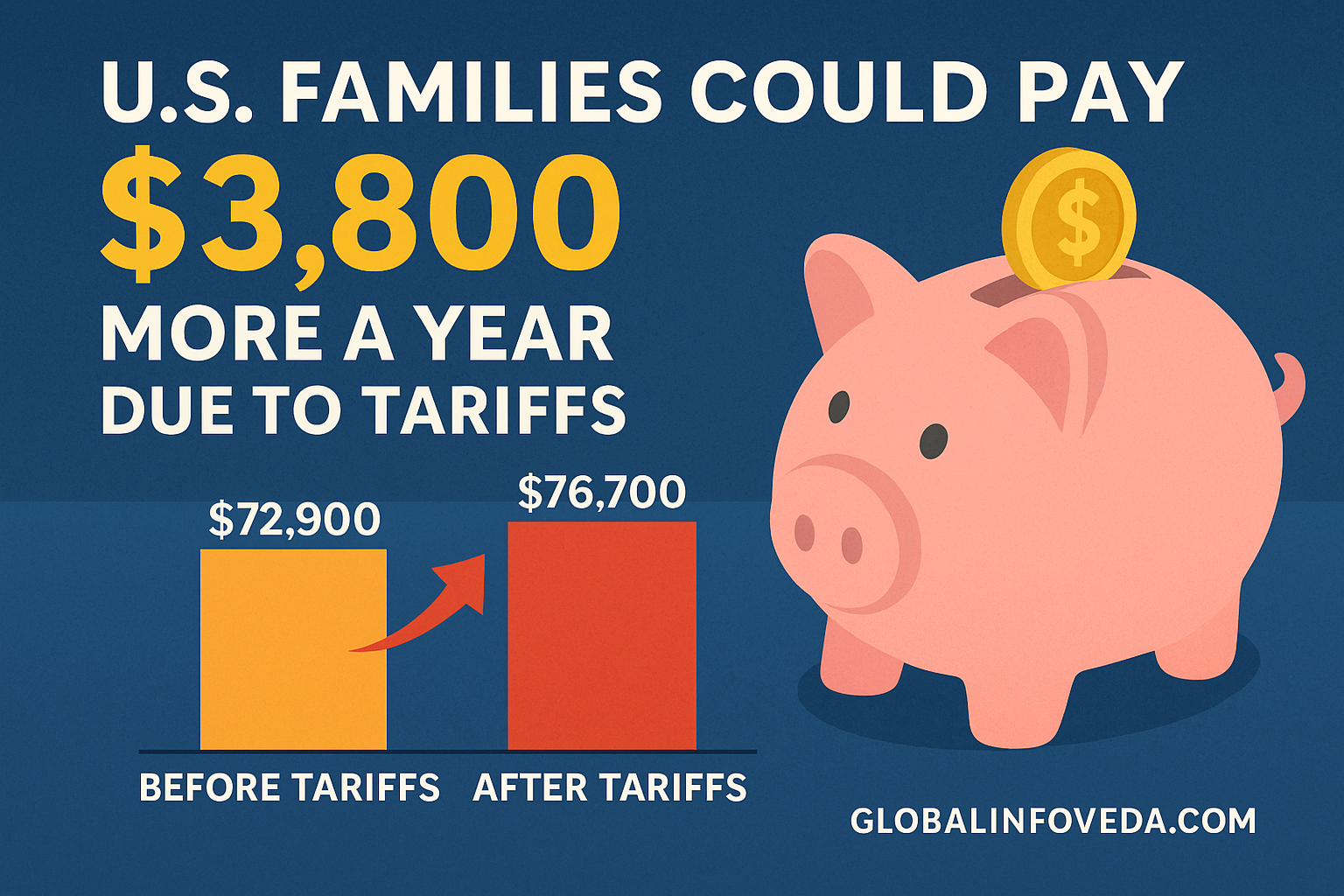U.S. Families Could Pay $3,800 More a Year Due to Tariffs
📌 Introduction: Hidden Tax on Households
A comprehensive economic assessment projects that U.S. households could face an extra $3,800 annually in expenses due to extensive tariffs on a wide range of imports. Policymakers present these measures as essential to safeguarding American jobs, strengthening domestic manufacturing, and countering unfair trade practices. However, critics highlight that these tariffs function as a hidden tax, pushing up prices on essentials like groceries, electronics, vehicles, and household goods.
This blog examines the breadth of the new tariffs, how they are likely to ripple through the economy, sector-specific vulnerabilities, and the potential short- and long-term effects on American families.
📊 Big Picture: What’s Driving the Cost Increase?
- Tariff Scope: Includes steel, aluminum, semiconductors, consumer electronics, vehicles, apparel, furniture, and select agricultural products.
- Projected Household Impact: Around $316 per month in additional spending.
- Inflation Pressure: Could further strain households already impacted by high fuel, housing, and healthcare costs.
- Most Affected Sectors: Retail, automotive, construction, high-tech manufacturing, and food supply chains.
| Category | Example Products | Tariff Rate Range | Likely Price Increase | Sectoral Impact |
|---|---|---|---|---|
| Metals & Materials | Steel beams, aluminum sheets | 15–25% | Construction and auto costs up 5–8% | Delays in infrastructure and manufacturing projects |
| Electronics | Laptops, smartphones, chips | 10–20% | Consumer electronics up 6–10% | Potential shortages, delayed tech rollouts |
| Food & Agriculture | Dairy, soybeans, processed foods | 8–15% | Grocery bills up 3–5% | Strain on lower-income households |
🔍 Sector-by-Sector Impact
1. Household Budget Strain
- Higher grocery, energy, and utility bills will reduce discretionary spending.
- Families may cut back on non-essential goods, impacting restaurants, entertainment, and travel.
2. Supply Chain Disruptions
- Auto and electronics industries dependent on imported chips and components could face production delays.
- Higher input costs may reduce profit margins and trigger price hikes across multiple product lines.
3. Small Business Vulnerability
- SMEs often lack the financial buffer to absorb increased costs.
- Independent retailers may struggle to compete with large corporations that can negotiate bulk purchase discounts.
| Impact Area | Risk Level | Short-Term Effect | Long-Term Effect |
|---|---|---|---|
| Large Corporates | Moderate | Offset costs with reserves | Reconfigure supply chains toward domestic sourcing |
| SMEs | High | Profit margin squeeze | Risk of downsizing or closure |
| Consumers | High | Pay more for essentials | Long-term erosion of purchasing power |
📈 Historical Context
- Smoot-Hawley Tariff Act (1930): Worsened the Great Depression by restricting global trade.
- 1980s Steel Tariffs: Provided temporary relief for U.S. steelmakers but hurt industries reliant on steel.
- Early 2000s China Steel Tariffs: Generated mixed results, with modest domestic gains offset by retaliatory measures.
📉 Broader Economic Implications
- Inflation Persistence: Tariffs can entrench inflation by embedding higher production costs across supply chains.
- Global Trade Relations: Retaliation from trade partners could curb U.S. exports, especially in agriculture.
- Job Market Shifts: While some manufacturing jobs may be created, service sector jobs could be lost due to reduced consumer demand.
- Regional Disparities: Manufacturing-heavy states in the Midwest and agricultural states in the Plains could bear disproportionate economic pressure.
🔮 Potential Long-Term Scenarios
- Positive: Increased domestic production capacity, improved supply chain security, and job creation in select sectors.
- Negative: Persistent high inflation, slower GDP growth, reduced global competitiveness.
- Adaptive: Businesses diversify sourcing, invest in automation, and target alternative export markets.
💡 Final Insight
If these tariffs remain in place, U.S. families could face the steepest cost-of-living increase in over a decade. While the policy may strengthen certain industries, the cumulative impact on household finances and consumer confidence could reshape spending patterns, business strategies, and even electoral politics in the years ahead.
Stay informed on global trade and economic policy at GlobalInfoVeda.com
